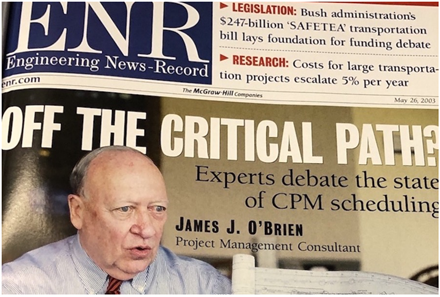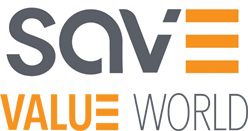By Stephen Kirk, PhD, FAIA, CVS-Life – Dean, College of Fellows
We say farewell to innovator James O’Brien, FSAVE at 91 years old. He died on December 31, 2020 in Yardley, PA of natural causes, according to his family. He was another early pioneer for Value Engineering (VE) and worked with Don Parker to write the book, Value Analysis in Design and Construction. VE was as an integral part of the project delivery systems employed to successfully manage both cost, schedule, and the quality of a project.He was also an innovator in the use of the critical path method for construction. ENR recognized him for this and other contributions. See illustration below:

James was co-founder and former CEO and chairman of O’Brien Kreitzberg, a construction management firm. It was formed in 1965 with partner Fred Kreitzberg and became the largest pure CM firm in the U.S. in the 1980s. VE was a part of the methods he employed to meet budgets and add value to projects. The firm also honed the CPM approach on projects that ranged from fast-track renovation of San Francisco’s cable car system to program management for redevelopment of New York City’s JFK International Airport.
Jim was an engineering graduate of Cornell University and a U.S. Navy veteran of the Korean War. He wrote the first CPM textbook in 1965, a best seller and staple of academic study now in its eighth edition, as well as 11 other books. O’Brien and Kreitzberg used CPM as the basis of a Management Information System (MIS) to support the U.S. Army Corps of Engineers in construction of ground facilities for the Saturn rocket program at Cape Canaveral, FL., a successful venture that led to NASA choosing the engineers and their team to develop a similar system for all aspects of the Apollo space travel program. CPM advocate Fred Plotnick, an O’Brien text co-author, says he “literally took this new tool for speeding project delivery to the moon by introducing [it] to NASA.”
In a 1994 ENR firm profile, Kreitzberg said O’Brien had “the most logical mind of anyone I’ve ever known.” In 1968, O’Brien led a team to “apply the successful Cape Canaveral approach” to New York City’s capital program, which had a $4-billion public works backlog, and needed to expedite projects to the bid stage, says one biography. O’Brien-Kreitzberg Associates eventually headed a team monitoring 2,500 projects. Says Richard LaRuffa, a former engineering manager at the firm: “We always worked as a team, and although Jim was the team leader he often worked as hard as every member.”
Despite CPM’s high-tech underpinning, O’Brien said in a 2003 ENR cover story that he had “a sci-fi feeling that computers are being used to steal control of the art of planning and scheduling.” Among his many industry involvements, O’Brien helped found the Project Management Institute and supported SAVE International.
He was inducted into the National Academy of Engineering, and was a Fellow of SAVE International, the American Society of Civil Engineers, the Project Management Institute, and the Construction Management Association of America.
Following are remembrances and tributes from members of SAVE and the SAVE College of Fellows.
“I started working for Jim O’Brien in 1972 before OKA was formed. Jim was not only a respected authority in the construction industry, but he was also a great boss and mentor. He guided me in my early career on how to succeed in the tough NYC arena of contractors, design professionals and public officials. Whether managing complex construction projects such as Bellevue Hospital and World Financial Center, conducting VE workshops on building, transportation, heavy construction, or military projects, or performing forensic analyses on construction disputes and claims, Jim approached each assignment with enthusiasm and professionalism. We always worked as a team, and although Jim was the team leader he often worked as hard as every team member. Jim taught me that success was dependent on your ability to communicate with everyone involved in a project. It did not matter if you were a Design Manager, Construction Manager, Project Manager or VE Team Leader – you were managing people, and you had to communicate respect for their perspectives while eliciting their participation in a productive manner. Jim encouraged me to become involved with SAVE and CMAA and supported my serving in positions of chapter officer and board member. After retiring we would often meet for lunch to recollect the challengers and characters we encountered over the years – many great stories. Rest in Peace.” – Rich LaRuffa
“Sad news, indeed. I did not have much interaction with Jim but had great respect for all he did for VM and SAVE. Our fellow’s ranks are dwindling. We should cherish all our colleagues, family, friends, and every day. My condolences to Jim’s family.” – Drew Algase
“Unfortunately, we have lost many of the founding fathers of our industry. I did not know Jim O’Brien well, but he was definitely a factor in my relationship with the value process. He conducted the first value engineering study I was ever a part of. I was one of the designers on a combined sewer overflow diversion structure for the City of Atlanta in the late 1970s and Jim O’Brien was the VE team leader on that study. The study was conducted as a mandate of the EPA grant program at the time. As was customary in the EPA-guided VE program of that time, the VE team was pretty aggressive in advocating the VE ideas that they proposed. And, as designers experiencing VE for the first time, we were understandably pretty defensive. Nonetheless, some good ideas came out of the study and I believe were implemented. My feelings about VE were somewhat ambivalent at the time, as I recall, but as I learned more about the process after I later joined the staff of the City of Atlanta, I became intrigued enough to take the 40-hour Module I course from Glen Hart. That ultimately led me to what has proven to be a rewarding 35 + year careen in the value industry.” – Don Stafford
“I tried to think of any encounters I had with Jim, but I could not. I looked at the VA/VE/VM books lined up on the shelf behind my desk and there was his book, Value Analysis in Design and Construction. It may have been the first book on the subject I acquired after being named the VE Officer for the Chicago District U.S. Army Corps of Engineers. I checked inside the cover but unfortunately no autograph!” – Howard Ellegant
“I met Jim through connections with my own firm Construction Dynamics Group. While he was the leading CM person at the time, he was a very humble man who welcomed and encouraged young entrepreneurs. Jim wrote a total of twelve books sharing his expertise and guidance for the construction industry. I was asked to author the Value Engineering part of his Heavy Construction book for McGraw Hill, the publisher for many of his works. Jim’s use of Value Engineering was as an integral part of the project delivery systems employed to successfully manage both cost, schedule, and the quality of a project. He was honored by SAVE as a pioneer in the field.” – Larry Zimmerman
“James’ VE approach was more cost-driven than function-driven at NYC OMB likely due to his main focus on engineering and construction management. The OMB Program learned from such early experiences that overemphasis on cost over function is less likely to result in agency-accepted recommendations. As such, James helped with our learning curve in defining success.” – Jill Woller
“I did know Jim O’Brien from his time on the SAVE Board. At the SAVE Congressional Reception in 1988, O’Brien Kreitzberg had an exhibit booth. Jim introduced me to the gentleman at the booth – it was Mike Adams, who then worked at OKA. Several years later Mike and I married. Mike had known Jim for many years, and we kept in touch with him and Rita over the years. Jim was a special man – kind, honest, pleasant personality, and great sense of humor.” – Ginger Adams
